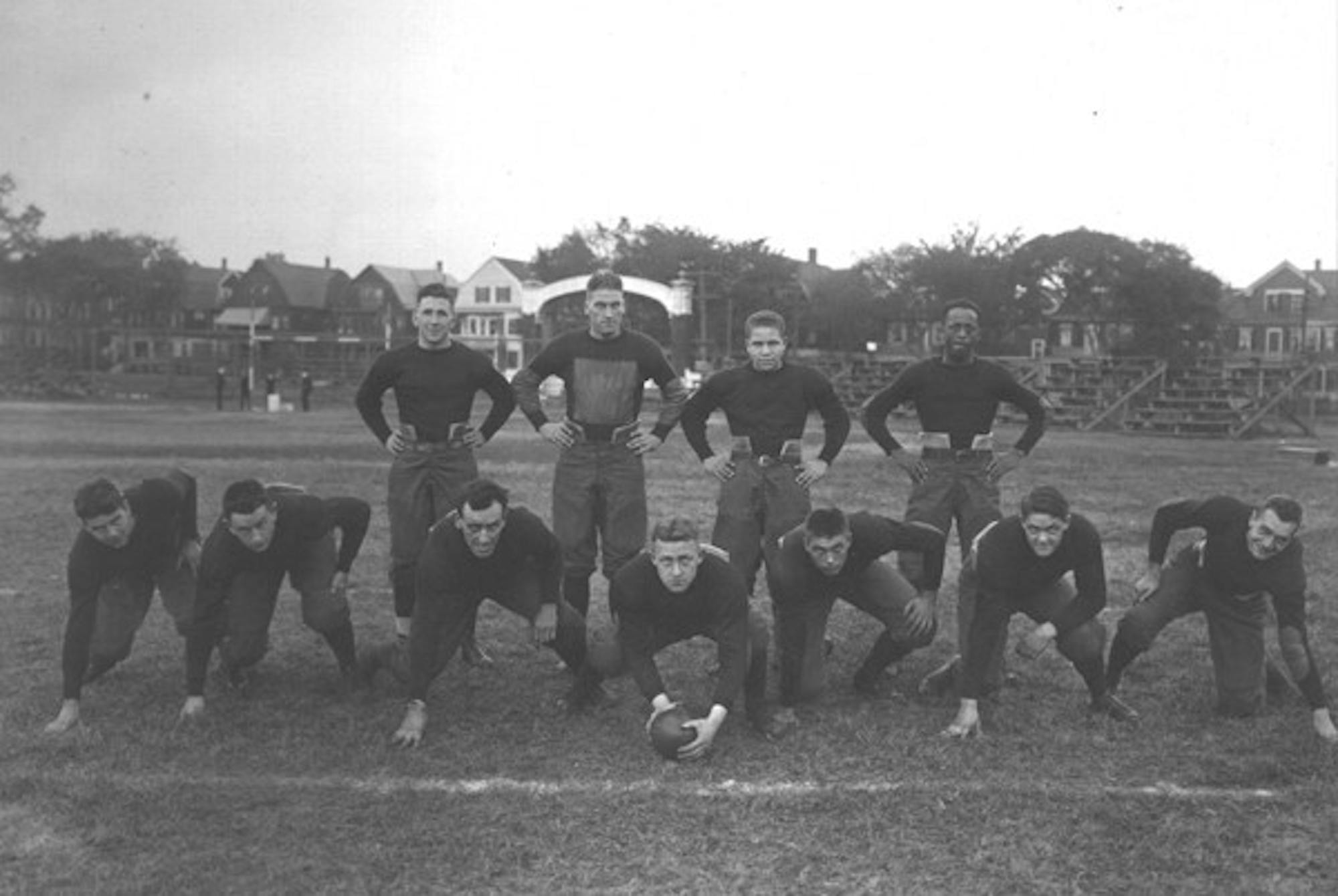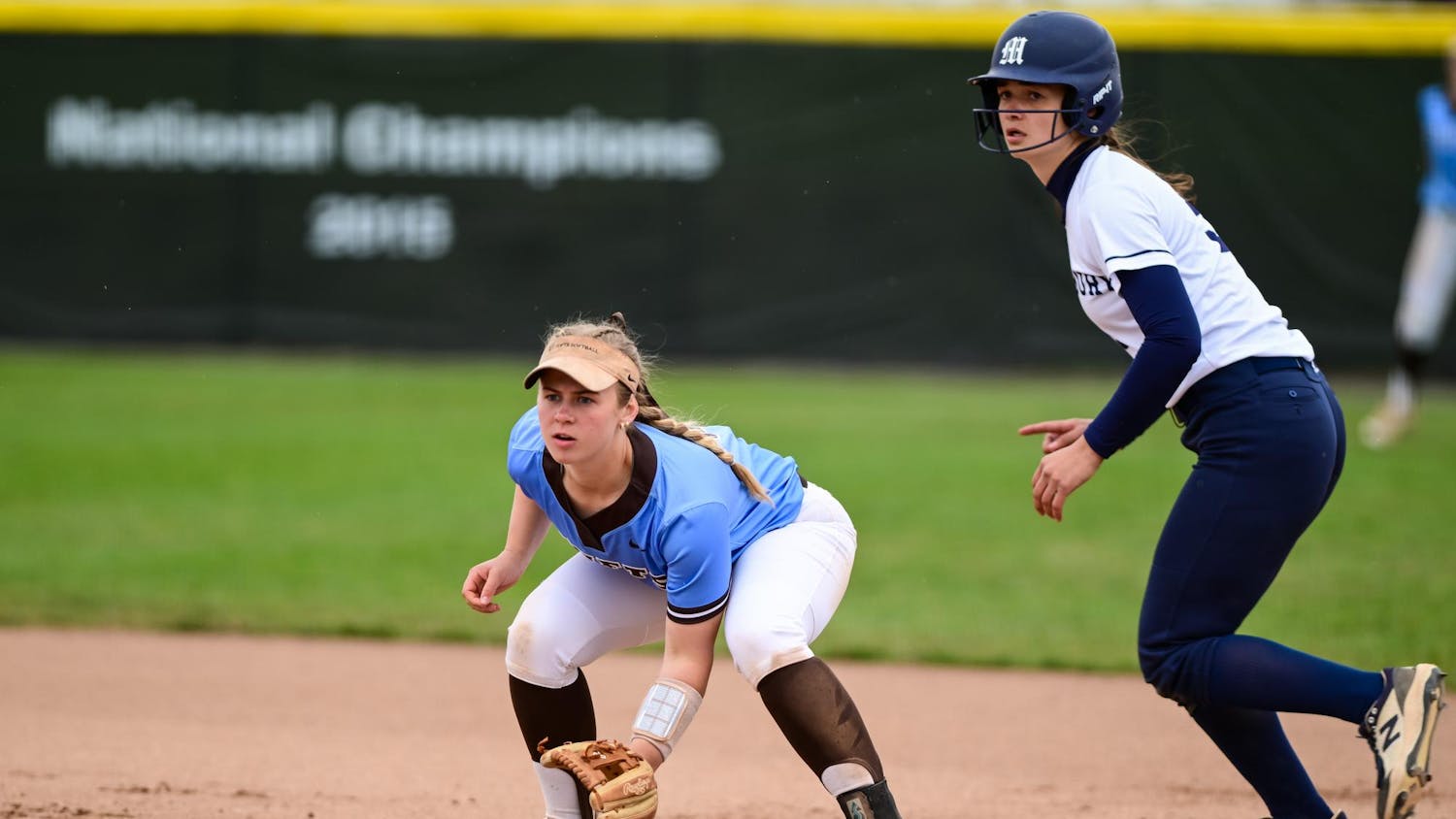Tufts College entered the 1917 football season without its head coach, Dr. Charles “Doc” Whelan. A former Dartmouth player, Whelan had already assembled a cumulative record of 48–38–4 in Medford, including five consecutive winning seasons. Whelan introduced a number of innovations to the game of football while at Tufts, including the Minnesota Shift in 1912 and the offensive huddle in 1916.
Whelan was more than just a pioneering coach. He was also an advocate for civil rights. In 1914, Whelan oversaw the racial integration of the Tufts football team with the addition of African-American left tackle William F. Brown. Though Brown deserves the lion’s share of the credit for his bravery and boldness, Whelan merits praise for his willingness to put social justice above any personal interest in avoiding controversy.
For example, the night before an important away game against Indiana in 1916, a nearby hotel refused to admit Brown and another black Tufts player: left guard Edward Morrison. In response, a furious Whelan threatened to take his team back to Massachusetts without playing — and thus forfeiting the game — unless all of his players were provided rooms. The hotel eventually relented, and in front of 35,000 fans the following day, Tufts beat Indiana 12–10.
In 1917, new developments in global politics sent shockwaves through the country. On April 6, the United States declared war on Germany and entered the First World War. Though rumors that Tufts might suspend all operations on account of the war were quickly put to bed, doubts about the fates of other activities remained.
The military conflict convinced a number of schools around the country to curtail or cancel their athletic engagements. Yet on Apr. 13, the advisory board for the Tufts College Athletic Association announced that the baseball and football seasons would carry on. Training for the six-game football season would begin in Medford on the first day of October.
The team was far from full strength, as many Tufts students joined the armed forces. According to a July 29, 1917 article in The Oregonian, 101 of Tufts’ 434 students had enlisted in the military, while most of those who remained behind were training for combat. In addition to those men who had graduated in 1916, nine football players left school for the armed services, including captain-elect fullback (and future NFL player) Erling E. “Dinger” Doane and halfback Owen Keefe.
Moreover, the football team not only lost players to the martial cause; it also lost its coach. The United States’ entry into World War I propelled Whelan into service to his country, and he left Medford for a stationing in Indiana with the Medical Corps. With Whelan absent, Richard C. Smith — a 1906 Tufts graduate, football administrator and assistant professor of structural engineering — became the team’s interim head coach.
An Oct. 10, 1917 article in the Tufts Weekly captured the atmosphere of the time: “War, the ever relentless and far-reaching God of Fate, deals his cards without thought of future consequences. In this respect Tufts College has suffered in all departments, but especially athletics.”
Dartmouth, meanwhile, entered the season with Dr. Clarence W. “Fat” Spears at the helm. Spears had played for Dartmouth as an offensive lineman in 1914 and 1915, earning All-American honors in both years.After spending a year coaching the school’s first-year eleven, Spears seized the reigns of the varsity squad in 1917. Despite losing a number of the team’s best players to the armed services, Spears began building a winning team for an eight game season.
Tufts lost its first three games of 1917. In the Oct. 12 season opener at Fenway Park, the men from Medford fell to Boston College, 20–0. An article in the Boston Herald and Journal reported that “the famous Tufts’ line shift was a failure,” and that the scoring disparity would have been wider had Boston College not committed three fumbles in the red zone. A week later, the U.S. Military Academy at West Point dispatched Tufts, 26–3. The sole points for the Brown and Blue came on a fourth-quarter field goal against West Point subs.
On Oct. 23, Tufts finally received some positive news. For reasons that have been lost to history, Whelan returned to coach and Keefe returned to play the rest of the 1917 season. Keefe’s absence had forced senior captain quarterback James J. “Jim” Drummey to play as a halfback on offense. Now, Drummey could return to his preferred position.
The coach and player’s return did not immediately translate into success, however. The season’s nadir came in a 58–0 defeat at the hands of Syracuse University on Oct. 27. During the second half of the one-sided encounter, Syracuse resorted to using its second- and third-string players against the futile Tufts offense.
After the humiliating loss, popular Boston sports columnist Bob Dunbar excoriated the Brown and Blue. “[You’ve] got to hand it to the Tufts team,” he wrote acerbically in t he Herald and Journal. “Syracuse failed to score 60 points.”
A number of Tufts students were similarly disgusted with the football team. An anonymous letter to the Weekly – simply signed as “SENIOR” – expressed the author’s angst and anxiety about the Brown and Blue eleven. The unnamed student challenged the players’ masculinity directly.
“TUFTS has a MAN for a coach and a MAN for a captain,” he wrote, “[but] she needs more MEN out for her football team: WHERE ARE THEY?”
Three games in, the season appeared doomed.
Meanwhile, the Dartmouth Green began 1917 with a 5–0 record. The Green won their first five contests by a combined margin of 83–21, highlighted by a 32–6 clobbering of Middlebury on Oct. 13. Standout Dartmouth players included captain quarterback Hubie McDonough and the halfback Holbrook brothers, Pat and Sid. Another valuable member of the team from Hanover was Eugene Neeley, a one-armed offensive guard who earned All-American Honors in 1917.
In the wake of Dartmouth’s heady start to the season, multiple pundits named Dartmouth as a serious contender for the national championship. An Oct. 23 column in the Trenton Evening Times listed the Green among the “big five” teams in the country. Likewise, an Oct. 27 article in the Sunday Herald recognized Dartmouth as “logical contenders for championship honors.”
The best the Brown and Blue could hope for, meanwhile, was a .500 record. After the Syracuse humiliation, Tufts’ next two games were at home in Medford. With Whelan firmly established, the Brown and Blue won both contests at the Oval. On Nov. 3, Tufts outshone New Hampshire State, 19–3. Smith — now returned to his role as football administrator — later recalled that the first win was “a turning point … in a marked degree.” Indeed, a week later, Tufts eked out a 6–0 victory over Colby College.
In contrast, Nov. 10 brought the first defeat of the season for the Green, as Dartmouth fell to the University of Pennsylvania Quakers, 7–0. Despite a heartbreaking fourth-quarter loss, however, Dartmouth still figured to be heavy favorites at a neutral site against Tufts. A loss to a 6–2 Quaker team was no embarrassment for the Green, while the Brown and Blue had only two wins against mediocre competition. Moreover, on the 13 previous occasions that the schools had played, Dartmouth had beaten Tufts 12 times and tied once. Few observers expected anything other than another Green rout of the Brown and Blue.
In the two weeks leading up to the contest, Whelan engaged in a fair amount of gamesmanship. According to an article in the Weekly from the issue following the Dartmouth game, Whelan “had meetings every night … with the Tufts correspondents of the Boston papers, instructing them to play up straight football of the old-fashioned line-plunging variety.” In secret, however, Whelan was coaching his players on “perfecting forward pass and end run plays built around Captain Drummey.”
At 10:00 a.m. on Nov. 17, over 150 Tufts players and fans — collectively constituting more than half of the entire student body — departed Medford by train. After completing their 50-mile journey north to Manchester, N.H., the travelers made their way to Textile Field for the early afternoon kickoff.
After winning the toss and returning the kickoff to their 38-yard line, Dartmouth’s offense started well. Slowly but surely, the Green drove the ball down the field to within a yard of the Brown and Blue goal line. Sid Holbrook fumbled, however, and Drummey recovered the ball.
A fortnight of subterfuge paid off, as the Dartmouth defense was entirely unprepared for Tufts’ mix of end-run plays and long passes. After Drummey ran around his left end for a 25-yard gain, the Brown and Blue stitched together a series of short running and passing plays to press the Green defense into retreat. Tufts scored its first touchdown of the game on a 3-yard left-end run by Drummey. Sophomore fullback Edmund J. McNamara kicked the extra point for an early 7–0 lead.
After the Tufts defense forced a Dartmouth three-and-out, Drummey went back to work. On the second play of the second drive, Drummey connected with junior halfback W. B. G. Mitchell for a 35-yard completion. Three plays later, Drummey found Mitchell again for a 30-yard touchdown reception. McNamara missed the point after attempt, leaving Tufts with a 13–0 advantage.
After the teams exchanged possessions several times through punts and turnovers on downs, the Brown and Blue scored once more on its final drive of the first half. Starting at Tufts’ 37-yard line, Drummey led his team up the field with skillful long passes. First, he found junior right end Frank W. “Link” Lincoln, Jr. for a 23-yard completion that brought the Brown and Blue to the Green’s 40-yard line. Two plays later, Drummey connected with Mitchell for a 40-yard touchdown pass. McNamara nailed the extra point to expand the Tufts lead to 20–0. Dartmouth’s last drive of the half came to nothing, and Tufts entered the break with a three-score advantage.
Tufts added to its lead at the start of the second half. Drummey returned the Dartmouth kickoff to Tufts’ 38-yard line to give his team good starting field position. On the third play of the drive, Drummey threw the ball 30 yards to senior left end Henry F. “Dutch” Jochim.Catching the ball near the Green’s 35-yard line, Jochim feinted past an opposing defensive back and sped to the end zone. McNamara’s third successful extra point of the afternoon gave Tufts a decisive 27–0 lead.
The rest of the contest was a foregone conclusion. The Weekly’s postgame report noted that the Jochim touchdown “took all the fight out of the Dartmouth team.” Though the Green attempted repeatedly to avoid a shutout, their offensive woes persisted as the Brown and Blue defense held firm. Having failed to implement a successful passing attack of their own, Dartmouth reverted to what an Associated Press report from the game described as “old style football” — running the ball up the gut.Yet the relentless effort of numerous members of the Tufts defense, including Mitchell and first-year halfback J. E. Martin, kept Dartmouth scoreless.
At the final whistle, the Tufts supporters charged onto the field and hoisted the football players onto their shoulders, carrying their heroes to the dugout. The boisterous backers of the Brown and Blue eventually made their way into downtown Manchester, holding up traffic as they celebrated their unlikely victory.
The losing streak was over. At last, on its 14th try, Tufts had beaten Dartmouth.
After the game, Whelan did not attempt to conceal his joy. “My ambition of a lifetime is realized,” he told the Weekly. “Those boys could beat any team in the country today … for there’s no stopping those forward pass plays.”
The press — both local and national — expressed shock at the result. In the issue following the win over Dartmouth, the front page headline of Weekly declared, “Tufts Closes Season in Blaze of Glory, Defeating Dartmouth 27 to 0.”The paper dedicated the majority of its first three pages to celebrating and dissecting the victory.
Nor was the excitement confined to Medford alone. Boston Post columnist Arthur Duffey declared that the Tufts-Dartmouth result “was the biggest upset in the college football season to date. Coach Doc Whelan must have worked wonders with Tufts since his return to the team.”
Adopting a more demure tone, the AP game report referred to the result as a “surprise to New England football followers.”
Meanwhile, the columnist Bob Dunbar had changed his tune, no longer lampooning the Brown and Blue. He described Whelan as having “hopped into the Miracle Man class,” writing, “Tufts’ triumph over the Dartmouth eleven was one of those unexpected flashes which go so far to make college football a delightfully uncertain gamble.”
While Tufts’ season was over, Dartmouth had one more game to play. On Nov. 29, 1917, Dartmouth lost to Brown 13–0. What was once a team with championship aspirations was now a 5–3 squad that failed to score in any of their final three contests.
Meanwhile, in Medford, any memories of earlier troubles had faded away. The Weekly’s commencement issue summed up the sentiments of the Tufts football faithful: the Dartmouth game “proved to be a fitting climax to the season.”
Or as Richard Smith put it: “A victory over Dartmouth will make any season a success.”
“Miracle men”: Tufts football’s improbable 1917 win over Dartmouth

The Tufts Football Team pose on the Oval on Oct. 17, 1917.





